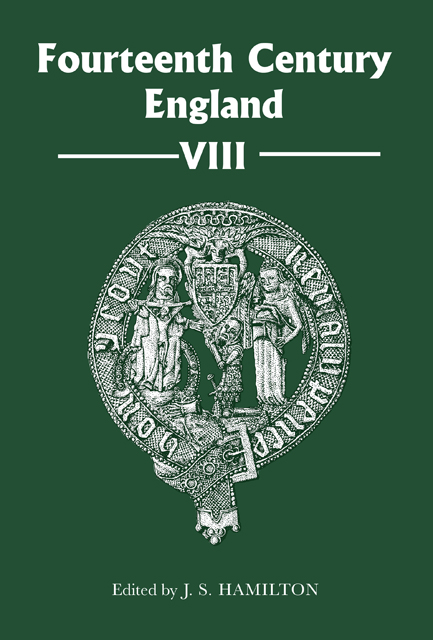Book contents
- Frontmatter
- Contents
- Contributors
- Preface
- Abbreviations
- King's Armourers and the Growth of the Armourer's Craft in Early Fourteenth-Century London
- In the Best Interest of the Queen: Isabella of France, Edward II and the Image of a Functional Relationship
- The First Entry of the Bishop: Episcopal Adventus in Fourteenth-Century England
- Temporalities Be Taken: Edward III, Unruly Ecclesiastics and the Fight for the Benefices of Exeter, 1337–60
- The Armour of Sir Robert Salle: An Indication of Social Status?
- Richard II, the Mortimer Inheritance and the March of Wales, 1381–84
- War, Chivalry and Regional Society: East Anglia's Warrior Gentry before the Court of Chivalry
- A ‘Sterre of þe See to ȝyue Lyȝt to Men’ and ‘Myrroure to Alle Sinful’: A Comparative Analysis of Biblical Women in the English Wycliffite Sermons with John Mirk’s Festial
- Index
- Fourteenth Century England issn 1471–3020
Richard II, the Mortimer Inheritance and the March of Wales, 1381–84
Published online by Cambridge University Press: 15 February 2023
- Frontmatter
- Contents
- Contributors
- Preface
- Abbreviations
- King's Armourers and the Growth of the Armourer's Craft in Early Fourteenth-Century London
- In the Best Interest of the Queen: Isabella of France, Edward II and the Image of a Functional Relationship
- The First Entry of the Bishop: Episcopal Adventus in Fourteenth-Century England
- Temporalities Be Taken: Edward III, Unruly Ecclesiastics and the Fight for the Benefices of Exeter, 1337–60
- The Armour of Sir Robert Salle: An Indication of Social Status?
- Richard II, the Mortimer Inheritance and the March of Wales, 1381–84
- War, Chivalry and Regional Society: East Anglia's Warrior Gentry before the Court of Chivalry
- A ‘Sterre of þe See to ȝyue Lyȝt to Men’ and ‘Myrroure to Alle Sinful’: A Comparative Analysis of Biblical Women in the English Wycliffite Sermons with John Mirk’s Festial
- Index
- Fourteenth Century England issn 1471–3020
Summary
Few things were as important to the late medieval nobility as the secure preservation of their estates and the right of their heirs to inherit unhindered. As Plucknett wrote, ‘in a turbulent world, the idea of inheritance was one which all accepted without question as part of the natural order … the most telling charge which could be brought against a tyrant was to say that he had thrust men out of their inheritances.’1 As a king who would ultimately be deposed for breaking this very principle, Richard II first gave his subjects cause for concern over this issue through his mishandling of the Mortimer inheritance after it fell into royal hands in late 1381. The unexpected death in Ireland on 27 December that year of Edmund Mortimer, earl of March, not only removed one of the most promising members of the nobility from the domestic political scene, it also left his vast inheritance in the hands of his nine-year-old son and therefore subject to the royal prerogative of custody. Edmund’s wife had predeceased him in 1378 but his mother, the long-widowed Countess Philippa, was still alive at the time of his death and she held over a third of the family’s estates either as dower or in jointure with her late husband. However, she too passed away shortly afterwards, dying on 5 January, and so by early 1382 the entire family inheritance had passed into royal hands for what looked likely to be a long minority. Over the next two years Richard’s treatment of these estates would prove sufficiently controversial to provoke a major clash between the king and certain of his nobility, to the extent that custody of the inheritance was eventually removed from his hands. The affair therefore stands as perhaps the earliest occasion in the reign that Richard’s subjects took it upon themselves to resist him and the first time that royal policy and the king’s attitude towards his subjects’ property became issues of contention.
What was it about Richard’s handling of this minority that was so controversial? According to the chronicler Thomas Walsingham, it was the king’s choice of custodians for the estates.
- Type
- Chapter
- Information
- Fourteenth Century England VIII , pp. 95 - 118Publisher: Boydell & BrewerPrint publication year: 2014



